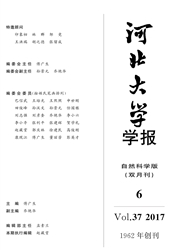

 中文摘要:
中文摘要:
采用双层耦合的CIMA模型,研究了不同图灵模相互作用时斑图的选择、形成机制.结果表明:当2个子系统分别处在超临界和次临界分岔点附近时,超临界图灵模和次临界图灵模相互作用产生耦合,得到六边形和超六边斑图;当2个子系统激发的图灵模均为超临界模时,二者之间不发生耦合,每个子系统各自形成简单的条纹斑图;当2个子系统激发的图灵模均为次临界模时,2个模产生相互作用,系统最终选择完全相同的“豆角”斑图.此外,图灵模的分岔类型还改变斑图的空间对称性.
 英文摘要:
英文摘要:
Mechanisms of pattern formation and pattern selection with different Turing modes interac- tion are investigated by using a two-layer coupled CIMA model. It is shown that hexagonal superlattice and simple hexagon arise respectively in subsysteml and subsystem 2 under the condition that two subsystems locate at supercritical or subcritical bifurcation point. Both of them in two subsystems cannot interact when the two Turing modes are supercritical and one simple stripe pattern in each of sub-systems emerges spontaneously. The identical 'bean' patterns is selected in the two subsystems when two Turing modes are subcriticl. In addition, the bifurcation types of the Turing modes also affect the spatial symmetry of the emerging patterns in system.
 同期刊论文项目
同期刊论文项目
 同项目期刊论文
同项目期刊论文
 期刊信息
期刊信息
